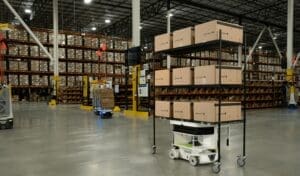
Historically, a warehouse management system used slotting and waving functionality to optimize the work in a distribution center. Slotting improves picking efficiency by putting the most popular items in locations closer to the shipping docks and at a height on the rack that is easy for a picker to reach. Waving intelligently groups the tasks that need to be completed to reduce associate travel times and improve throughput. In the more manual part of a warehouse, WMS waving is the key optimization tool.
In some DCs, there is a high degree of automation, as conveyors and other forms of advanced automation rapidly move goods from one part of a warehouse to another. A WMS needs a warehouse control system to control the material handling equipment. The WMS owns the higher-level order information – it understands what orders must be fulfilled, what line items make up the order, and the cutoff times for when that work must be done.
The WCS has the MOVE logic. The WMS tells the WCS, “MOVE this carton from point A to point B,” and the WCS has the logic to accomplish that task.
Warehouse Execution Systems
But then, the e-commerce and robot revolutions occurred. Warehouse workers work alongside autonomous mobile robots to fulfill orders. Warehouse execution systems emerged to optimize work across both the manual and more automated parts of the warehouse. Körber and other leading WMS providers offer WES that is seamlessly integrated into the core WMS solution.
Some robotic solutions don’t allow the WES to optimize the work they do. The warehouse mobile robot system downloads orders from the WMS for the work that will be done in its zone. The more orders it downloads, the greater the ability of the AMR system to intelligently group orders and increase throughput. If everything works smoothly, this is great.
Mr. Kramer argues that more warehouses will combine manual work with autonomous mobile robots and high-velocity bolted-down automation. Ultimately, the key to better optimization is who owns the inventory. Intelligent mobile robots, warehouse robots capable of optimization, can only control the work that is in their zone.
Körber believes that a better solution is for the warehouse execution system to control all the work across all the zones in the warehouse. Then, based on that control, the WES can appropriately orchestrate all the work. For example, the AMR zone may need additional inventory as work proceeds. The WES can direct that the necessary inventory be put away in the zone where the robots are working.
Or, a bot might break down, and work in the robot zone is not proceeding as quickly as planned. The WES can reprioritize the work that needs to be done, some of which is done by bots in conjunction with people, some just by people.
Mr. Kramer pointed out that as soon as an order spans multiple zones, intelligent AMRs are incapable of global optimization.
While Körber works with multiple different AMR providers, the “white box” AMR solutions allow for better warehouse optimization. With white box solutions, In the white-box scenario, the WES can basically control everything; it has complete control of everything that’s going on inside the AMR zone. In this scenario, it becomes possible for a WMS provider to write extension logic to the WMS that mimics what intelligent robotic solutions can do.
With gray box AMRs, the WMS can send order lines. In this scenario, the WES can now start manipulating what it wants to do with the inventory. For example, the WES may want the inventory picked from location X rather than location Y.
Intelligent robots are based on black-box solutions. “I can only send them the order; that’s the only thing that their APIs will support,” Mr. Kramer exclaimed. So, the WES has no control over what happens in the AMR work zone.
Locus Robotics
WMS executives acknowledge that a WES solution may have limited value if a warehouse focuses solely on e-commerce or spare parts each picking.
Locus Robotics is one of the largest suppliers of warehouse mobile robots. This is an intelligent solution. The optimization done in a Locus solution is arguably more complex than that of a WMS. While a WMS’s key optimization variables include inventory availability, order priority, tote types and pack hierarchies, and warehouse layout/minimized travel, the Locus solution includes those variables but solves the minimized travel problem by orchestrating the movement of man and machine.
However, what matters more than the complexity of the math are the results. The throughput of human plus bot exceeds what a manual warehouse can do. Locus Robotics’ new throughput record is 140,000 units picked in an hour at a large site with over 100 bots.
Now that Locus has introduced bots with larger payloads, its value proposition extends beyond each picking to include case picking. This begins to break down the global optimization argument made by WMS vendors. Features like put away, pick and pass, put walls, and interleaving can now be done not just by a WMS but also by the Locus system.
Conclusion
A well-known supply chain consultant, David Landau, pointed out that top WMS vendors consider the warehouse execution system strategic. If a potential customer can buy a low-cost warehouse management system and add mobile robots to improve optimization and throughput, why should they pay for a top-tier WMS?
The answer may be that optimizing the warehouse is insufficient; companies should also optimize their end-to-end supply chain. In the past, supply chain suppliers argued that if you transportation management, supply chain planning, and WMS, you could optimize end-to-end. That was not fully true. When solutions had to be integrated, the clunky data pass-offs prevented full optimization.





















